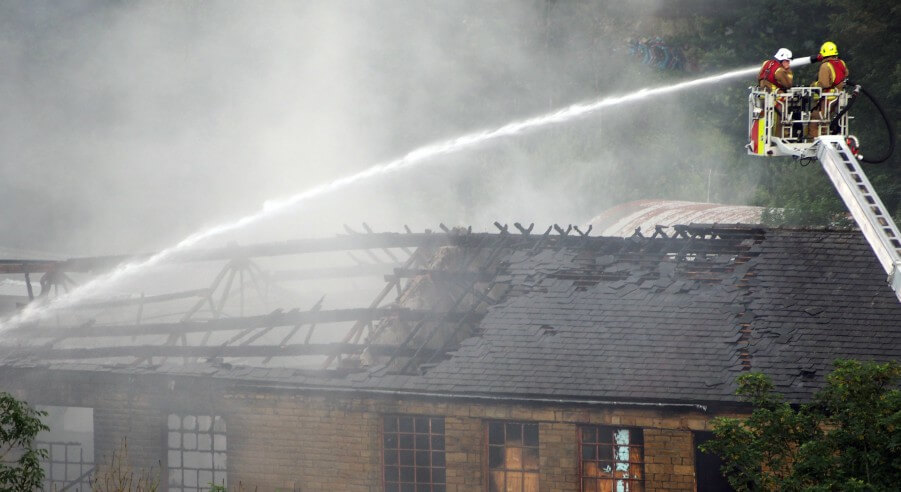
Trouble at Mill When it Comes to Insurance
The north’s cotton, wool and textile mills, warmly regarded as part of the region’s living history by authorities like Historic England, are becoming increasingly difficult to insure, in part because of their past lives, but also due to present-day issues that are hot potatoes.
The nature of textile mills’ construction, and the trades formerly carried out within them, make them more of a fire risk than other buildings, whilst arson and current-day usage or non-usage of a mill, often attract the wrong headlines for leading insurers selecting what to insure.
The issue
Whereas 500,000 people in Lancashire – from a population of four million – were once employed in the textile mills driving the Industrial Revolution, the legacy of those heady times is a landscape of neglected buildings awaiting renovation. These former textile mills sit alongside other mills that have found another purpose in life, but one often riddled with risk.
Buildings insurance is hard to find for property owners hanging on to a mill in the hope of a future redevelopment, such as an apartments renovation. Insuring mill premises is also difficult for anyone who has taken over a mill to run some modern-day form of textile-related business, or to be a landlord to an array of tenants working from offices or workshops within the old mill building. In this scenario, having a variety of different businesses under one roof increases the fire-risk and lessens the degree of control over risks, from an insurer’s perspective.
The longer a mill stands empty, the greater the capacity for it to attract vandals and also arsonists. Arson has been on the rise in the UK, with 50.5% of all fires attended by the Fire & Rescue Services in 2017-18 being arson related. Being empty also makes a mill attractive to rough sleepers, who could accidentally start a fire within.
A mill sometimes has to cope with more than one arson attack. Elisabeth Mill in Stockport (now renovated) and Gidlow Mill in Wigan, suffered several attacks, whilst Maple No 1 Mill in Oldham experienced six arson attacks in 2016, finally burning to the ground.
Getting their fingers burned
Insurers have also suffered losses as a result of insuring mills. This has revolved around a facet of insuring a cotton or textile mill that causes problems – the sum insured. Mills should be insured for their rebuild value, but this is often far more than their market value. Should a total loss occur, insurers often get their fingers burned by the payout.
One example of this related to the Crossfield Works mill in Rochdale, insured by owner, Sartex Quilts on a reinstatement basis, in 2011. When a clothing-handling machine blocked, a fire started and not only led to a loss of life, but also destroyed all buildings, plant and machinery. Sartex claimed for property damage and business interruption, but the insurer tried to pay out only for the market value of the mill, not the rebuild cost. The insurer lost their fight at the High Court and had to pay the reinstatement cost, minus a 20% co-insurance provision that had been agreed when the policy was taken out.
At other times, mill owners who do not realise it is the rebuild value they need to take into account, have insured their mills on the basis of market value. This causes issues at the time of claim, with insurers able to reduce the amount paid out, on the basis of a rule known as ‘average’, because the mill was underinsured. This can lead to devastating impacts for those who are underinsured.
Inherent Fire Risks in Textile and Clothing Mills
Mills were traditionally built to an open timber-floor construction, which encourages the rapid spreading of fire. Where wood has been replaced by other material, including cast iron supports, another issue arises, as applying cold water to hot cast iron, when putting a fire out, leads the cast iron to fail.
Fires and explosion in mills are often also due to the presence of ‘fly’ – deposits of fluff and dust emanating from textiles, which is light and very flammable if contaminated with oil, or lit by a spark from an electrical fault or machine. Bales of fabric are another issue, smouldering underneath if they catch fire, making it almost impossible to put the fire out. Wool dust can easily cause explosions, as can ground flock from cotton, acrylic and nylon fibres.
In the six years from April 2010 to September 2016, Bradford witnessed 103 of its mills in flames. Whilst 58 of the fires were attributed to arson (62% in derelict mills), 45 were due to other causes. Many of these accidental fires can lead to total dereliction of the mill’s structure, with that then being bulldozered and totally removed from the landscape.
The Picture and the Solution
Given all the factors that make mills such a huge fire risk, some mills have been lost to us forever, including Oxford Mills in Ashton-under-Lyne and the Bath Street Mill in Derby.
Insurers have either shied away from mill insurance altogether, restricted cover to FLEA perils – Fire, Lightning, Explosion and Aircraft impact – or charged phenomenally high premiums. This makes finding insurance a nightmare for property owners who do own mills.
Hope is at hand, however. Champion Insurance can access cover from some of the Lloyds of London syndicates who will still provide insurance policies for mills. As a result, we insure some of those mills that are still reminding the North of its industrial heritage, whilst helping their owners better manage their risk. The latter shows insurers that a client is serious about protecting their property, which makes them a more attractive customer to have on board.
If you own a mill and need to insure it, and get the right advice and sum insured on the documentation, please contact Champion on 03330 430 430. The team will help you find the insurance covers that you require, having become experts in this field.






